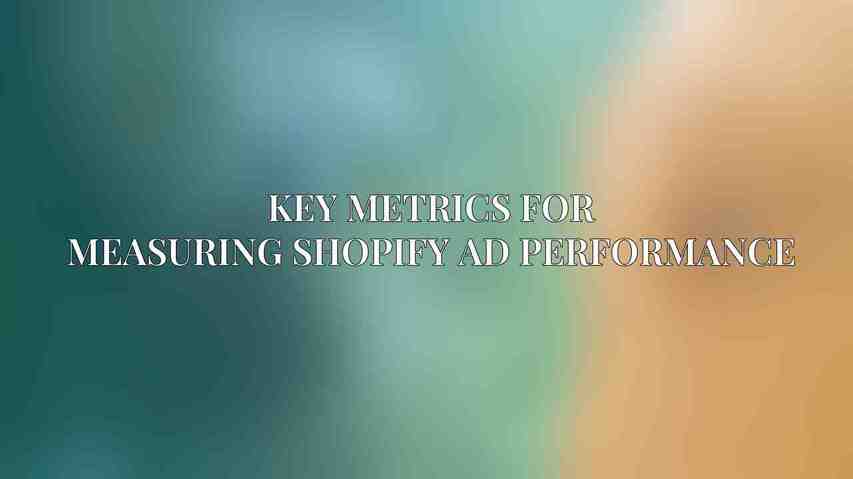Shopify Ads play a crucial role in the success of e-commerce businesses by driving traffic and conversions to online stores. With the growing competition in the digital world, optimizing Shopify Ads for maximum Return on Investment (ROI) is essential for businesses to thrive. Understanding key metrics such as ROI, Cost Per Acquisition (CPA), Click-Through Rate (CTR), and Conversion Rate is vital in evaluating the performance of these ads.
Importance of Shopify Ads for E-commerce
Shopify Ads serve as a powerful tool to attract potential customers, increase brand awareness, and ultimately boost sales. By strategically leveraging different advertising channels, businesses can reach a broader audience and drive qualified traffic to their Shopify stores.
Key Metrics for Measuring Shopify Ad Performance

- Return on Investment (ROI): The overall profitability of Shopify Ads, calculated by subtracting the cost of investment from the revenue generated.
- Cost Per Acquisition (CPA): The cost incurred to acquire a new customer through Shopify Ads.
- Click-Through Rate (CTR): The percentage of people who click on a Shopify Ad after seeing it.
- Conversion Rate: The percentage of ad clicks that result in a desired action, such as a purchase or sign-up.
Optimizing Shopify Ads Across Channels
When optimizing Shopify Ads across different channels, businesses can maximize their reach and engagement with potential customers. Here are some strategies for optimizing Shopify Ads on key platforms:
A. Google Shopping Ads
- Creating an effective product feed that includes accurate and up-to-date information.
- Optimizing product titles and descriptions with relevant keywords for better visibility.
- Managing negative keywords to refine targeting and avoid irrelevant clicks.
- Setting competitive bids to ensure ad placement against competitors.
B. Facebook and Instagram Ads
- Selecting relevant target audiences based on demographics, interests, and behaviors.
- Creating engaging ad creatives, including visual content and compelling copy.
- Using split testing to experiment with different ad variations and determine the most effective approach.
- Tracking and analyzing ad results to make data-driven decisions for future campaigns.
C. Search Engine Optimization (SEO)
- Optimizing product pages for relevant keywords to improve organic search visibility.
- Building high-quality backlinks to the Shopify store to enhance domain authority.
- Creating informative and engaging product descriptions that resonate with potential customers.
D. Email Marketing
- Segmenting email lists based on customer behavior and preferences for targeted campaigns.
- Personalizing email content to cater to specific audience segments and increase engagement.
- Automating email sequences to nurture leads and drive conversions.
- Tracking email open rates and click-through rates to assess campaign performance.
Managing and Tracking Shopify Ads
Efficiently managing and tracking Shopify Ads is essential to monitor performance and make informed optimization decisions. Here are key aspects to consider in this process:
A. Setting Up Shopify Ads Account
Creating a Shopify Ads account to access advertising tools and set up campaigns for different channels.
B. Campaign Creation and Structure
- Defining clear campaign objectives to align with business goals.
- Setting up ad budgets and schedules to control spending and ad delivery.
- Targeting the right audience through granular audience segmentation for better ad relevance.
C. Ad Creative Development
- Writing compelling ad copy that resonates with the target audience and drives action.
- Choosing eye-catching images and videos that capture attention and convey brand messaging effectively.
- Ensuring mobile responsiveness for ads to cater to users across devices.
D. Tracking and Reporting
- Using the Shopify Analytics dashboard to monitor ad performance and key metrics.
- Integrating with Google Analytics for more in-depth tracking and insights.
- Generating custom reports to analyze performance trends and identify optimization opportunities.
Advanced Shopify Ad Optimization Techniques
To take Shopify Ads to the next level, businesses can implement advanced optimization strategies to enhance targeting and performance:
A. Retargeting Campaigns
- Implementing strategies to target visitors who have abandoned their shopping carts for increased conversion rates.
- Creating compelling retargeting ad creatives that encourage users to return and complete their purchase.
- Optimizing retargeting bids to maximize ROI and reach high-intent customers.
B. Dynamic Product Ads
- Leveraging dynamic product ads to showcase personalized product recommendations based on user behavior.
- Setting up dynamic product ad campaigns to automate product promotion and increase relevancy.
- Implementing best practices for dynamic product ad optimization, such as updating product feeds regularly and testing different ad formats.
C. Conversion Rate Optimization (CRO)
- Making website improvements to enhance user experience and drive higher conversion rates.
- Conducting A/B testing to experiment with different website elements and determine optimal configurations.
- Tracking and analyzing CRO results to identify areas for improvement and maximize conversion opportunities.
Continuous optimization of Shopify Ads is critical in achieving long-term success and maximizing ROI in e-commerce. By implementing the right strategies and techniques, businesses can enhance their advertising efforts, reach their target audience effectively, and drive meaningful results. With a focus on ongoing improvement and adaptation to industry trends, effective Shopify Ad optimization can lead to increased sales, brand visibility, and customer engagement.
Frequently Asked Questions
What is the best way to design Shopify ads for maximum ROI?
Focus on eye-catching visuals, clear messaging, and targeted audience.
How can I track the performance of my Shopify ads?
Use Shopify analytics tools to monitor key metrics like click-through rates, conversions, and return on ad spend.
Should I A/B test my Shopify ads?
Yes, A/B testing can help you identify what works best for your audience and optimize your ads for better results.
How can I optimize my ad budget for Shopify campaigns?
Allocate more budget to high-performing ads and target audiences to maximize ROI.
What are some common mistakes to avoid when running Shopify ads?
Avoid targeting too broad of an audience, neglecting mobile optimization, or not optimizing ad copy for conversions.

